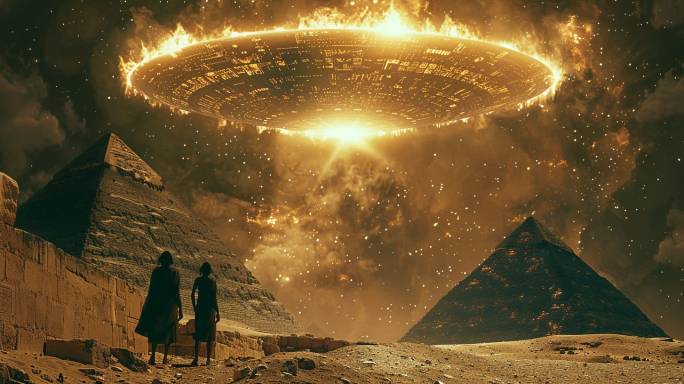Introduction
The Tulli Papyrus, often cited in discussions of ancient extraterrestrial encounters, remains one of the most intriguing and controversial artifacts in ufology. Describing mysterious “fiery discs” in the sky, the papyrus has fueled theories of ancient UFO sightings. Yet, questions about its authenticity and origins add a complex layer to this enigmatic text.
Discovery of the Tulli Papyrus
The Tulli Papyrus was reportedly discovered by Alberto Tulli, a director of the Egyptian Section of the Vatican Museum, in the early 20th century. Tulli allegedly found the papyrus in an antique shop in Cairo but could not afford to purchase it. He instead made a transcription of the text, which was later translated and published, bringing the document to the attention of the public and scholars.
Description of the Papyrus
The Tulli Papyrus contains descriptions of unusual celestial phenomena observed during the reign of Thutmose III around 1480 BCE. The most striking accounts are those of “fiery discs” that appeared in the sky, described in vivid detail. These discs were said to be brighter than the sun and emitted a foul odor.
“Fiery Discs” and UFO Theories
The mention of “fiery discs” has led to numerous theories about ancient UFO sightings. Some ufologists interpret these descriptions as evidence of extraterrestrial visitation in ancient times. The detailed accounts of the discs’ appearance and behavior suggest advanced technology far beyond the capabilities of ancient civilizations.
Historical Context
Placing the Tulli Papyrus in its historical context reveals a period of great achievements in ancient Egypt. Thutmose III was known for his military conquests and monumental building projects. However, there is no corroborating evidence from other Egyptian texts or artifacts that mention similar phenomena, making the Tulli Papyrus an isolated case.
Skepticism and Controversy
The authenticity of the Tulli Papyrus is highly debated. Critics argue that the lack of an original document and reliance on a transcription raises doubts about its validity. Additionally, some suggest that the text could be a modern forgery or a misinterpretation of natural phenomena.
The Role of Alberto Tulli
Alberto Tulli’s involvement adds another layer of intrigue. As a respected figure in the field of Egyptology, his discovery carries weight. However, the fact that Tulli never published the original papyrus and only a transcription leaves room for skepticism about the document’s authenticity.
Scientific Examination
Scientific examination of the transcription has been limited due to the absence of the original papyrus. Studies have focused on linguistic analysis and the plausibility of the described phenomena. While some researchers find the descriptions compelling, others point to inconsistencies and anachronisms in the text.
Debunking Efforts
Efforts to debunk the Tulli Papyrus have included linguistic analysis, historical cross-referencing, and attempts to trace the papyrus’s provenance. Skeptics argue that natural explanations, such as meteorological events or astronomical phenomena, could account for the “fiery discs” described in the text.
Supporting Evidence
There is little supporting evidence from other historical texts or artifacts to validate the Tulli Papyrus’s claims. This lack of corroboration from contemporary sources casts further doubt on its authenticity. However, proponents of the UFO theory argue that such events could have been intentionally omitted from other records due to their extraordinary nature.
Impact on Modern Ufology
Despite its controversial status, the Tulli Papyrus has significantly impacted modern ufology. It is frequently cited in discussions of ancient astronaut theories and has inspired numerous books, documentaries, and articles. The text’s vivid descriptions continue to capture the imagination of those intrigued by the possibility of ancient extraterrestrial encounters.
Ancient Astronaut Theory
The Tulli Papyrus is often linked to the ancient astronaut theory, which suggests that extraterrestrials visited Earth in antiquity and influenced human civilization. Proponents of this theory view the “fiery discs” as evidence of advanced alien technology witnessed by ancient Egyptians.
Myth vs. Reality
Distinguishing myth from reality is challenging when examining the Tulli Papyrus. While the text’s descriptions are captivating, the lack of concrete evidence and the possibility of forgery or misinterpretation make it difficult to draw definitive conclusions. The papyrus remains a blend of myth and potential historical reality.
Public Fascination
The Tulli Papyrus continues to fascinate the public due to its mysterious nature and the allure of ancient UFO sightings. Its blend of historical intrigue and speculative ufology ensures that it remains a topic of interest for both scholars and enthusiasts.
Conclusion
The Tulli Papyrus stands as an enigmatic artifact that blurs the lines between history, mythology, and ufology. While questions about its authenticity persist, its descriptions of “fiery discs” in the ancient sky continue to captivate and inspire. Future research and discoveries may one day unravel the true nature of this mysterious text, but until then, the Tulli Papyrus remains a tantalizing puzzle from the past.
FAQs
Q: What is the Tulli Papyrus?
A: The Tulli Papyrus is an ancient Egyptian text that allegedly describes sightings of mysterious “fiery discs” in the sky around 1480 BCE.
Q: Who discovered the Tulli Papyrus?
A: The Tulli Papyrus was reportedly discovered by Alberto Tulli, a director of the Egyptian Section of the Vatican Museum, in an antique shop in Cairo.
Q: Are the “fiery discs” described in the Tulli Papyrus evidence of ancient UFOs?
A: The descriptions of “fiery discs” have led to theories about ancient UFO sightings, but the authenticity of the papyrus itself is highly debated.
Q: What is the ancient astronaut theory?
A: The ancient astronaut theory suggests that extraterrestrials visited Earth in ancient times and influenced human civilization. The Tulli Papyrus is often cited in support of this theory.
Q: Is the Tulli Papyrus authentic?
A: The authenticity of the Tulli Papyrus is questioned due to the lack of an original document and reliance on a transcription. Some believe it to be a modern forgery or misinterpretation.

